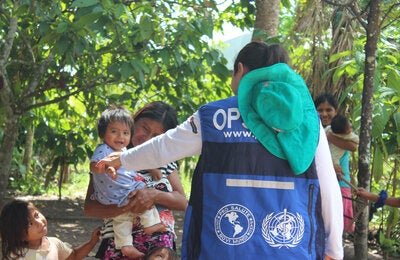
 The Pan American Health Organization's Director, Dr. Mirta Roses, today offered to make available an experienced regional response team to assist the region affected by the tsunami and earthquake that struck Samoa and Sumatra.
The Pan American Health Organization's Director, Dr. Mirta Roses, today offered to make available an experienced regional response team to assist the region affected by the tsunami and earthquake that struck Samoa and Sumatra.
Washington, October 2, 2009 (PAHO) — The Pan American Health Organization's Director, Dr. Mirta Roses, today offered to make available an experienced regional response team to assist the region affected by the tsunami and earthquake that struck Samoa and Sumatra.
During PAHO's Directing Council meeting this week, member states reiterated the importance of hospital safety and construction to avoid hospital collapse in natural disasters.
Although there have been many successes, much remains to be done to ensure that at least new hospitals are designed to remain functional in case of disasters, said Dr. Jean-Luc Poncelet, who heads PAHO's Emergency Preparedness and Disaster Relief area. "This region has several examples proving that even in less economically advanced countries, hospitals can resist hurricanes or earthquakes."
Typhoon Ketsana killed at least 422 people across Southeast Asia in recent days, and a tsunami that hit Samoa, American Samoa and Tonga killed at least 169 people, news reports said. A 7.6-magnitude earthquake in Indonesia left at least 715 dead, according to Indonesia's Health Ministry, with as many as nearly 3,000 people still trapped under collapsed buildings, including hospitals.
PAHO launched a safe hospitals initiative in 1990 that has already started to give results, Poncelet noted. The World Bank, the Organization of American States, the Inter-American Development Bank and the UN International Strategy for Disaster Reduction are among the entities that support the safe hospital initiative. The International Hospital Federation, which is also involved, has organized a session at its 36th World Hospital Congress in Rio de Janeiro November 12 to explore the issue of hospitals safe from disasters, along with PAHO and the World Health Organization.
WHO and its South-East Asia Regional Office are partnering with the UN International Strategy for Disaster Reduction (UN/ISDR) and the World Bank on the 2008-09 World Disaster Reduction Campaign, whose theme is Hospitals Safe from Disaster. Economic, health and social cases have been developed to support the need for action.
The Hospital Safety Index was developed through a lengthy process of dialogue, testing and revision, over a period of two years, initially by the Pan American Health Organization's Disaster Mitigation Advisory Group (DiMAG) and later with input from other specialists in Latin America and the Caribbean. It helps health facilities assess their safety and avoid becoming a casualty of disasters.
The Pan American Health Organization, founded in 1902, works with all the countries of the Americas to improve the health and quality of life of their peoples. It serves as the Regional Office of the World Health Organization (WHO).
For more information please contact Daniel Epstein, Information Officer, Knowledge Management and Communication, tel (202) 974-3459, fax (202) 974-3143.



